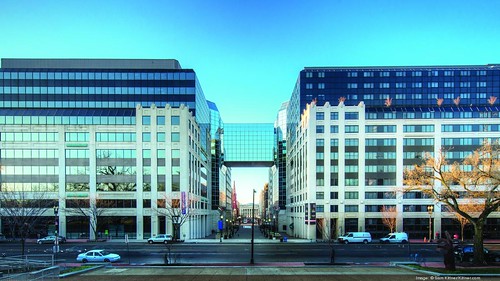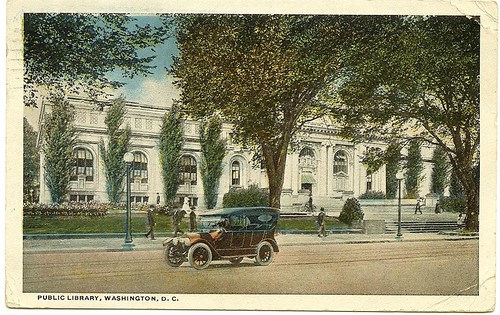Wanted: more systematic cultural planning in DC
Earlier in the week, it was announced that Events DC (the former Washington Convention and Tourism Corporation) and the International Spy Museum, have junked their attempt to make over the Carnegie Library site into a new home for the museum. See "International Spy Museum deal for Carnegie Library canceled" from the Washington Business Journal.
The project called for underground space as well as new wings to be built above-ground, significantly changing the nature of the landmarked building and site.
DC's historic preservation review process kept sending the proposals back for revision.
As is, the Carnegie building isn't great for a museum. Interestingly, when a colleague was the interim director of the Historical Society in 2006, we discussed how to relaunch a city museum and the fact that the Carnegie Library building doesn't have the kinds of spaces that a great city museum requires (for example, in comparison to the Pittsburgh History Center, one of the country's best city museums).
In our conversations, I referred to the first couple stories of the adjacent TechWorld building as the "museum annex" and the best place to try to expand the Museum and capture the kinds of spaces required for displaying "big stuff" like fire trucks, streetcars, old retail signs, etc.

The TechWorld building is on the left and the Renaissance Hotel is on the right in this Washington Business Journal photo.
The underground thing has been kicking around for awhile. For whatever reason, the "Growth Machine" has been trying to "fix" this building for awhile. A music museum was started there and lasted less than a couple years.
And the idea of moving the Central Library back there with an underground addition has been around for some time. I remember the then planning director suggesting it to me many years ago. I said the same thing, that the building site is too small, constrained, and that by contrast, the underground section of the Los Angeles Central Library was able to be much much bigger.
The thing is that ideas such as these never go away, they stay on the agenda, and get re-worked from time to time.

At the same time, I wrote a memo for a Historical Society board meeting, about the gaps in how the city plans for cultural facilities development and programming. See "Cultural resources planning in DC: In the land of the blind, the one-eyed man is king" which includes that memo at the end of the entry.
There isn't really a master plan for the city's cultural offer, nor for the cultural elements of Downtown DC. Although there are a bunch of items mentioned in various sections of the Center City Action Plan (2008). The circa 2000 Downtown Action Plan was more focused, calling for a strengthening of the theater district and an expanded central library-local cultural facility.
From the Downtown Action Plan:
Downtown needs a multi-use facility that can serve as a cultural information hub for the District. A redeveloped and expanded Martin Luther King, Jr. Library could be adapted to serve as a dual-purpose cultural center and headquarters library. This site is ideal as it is near Gallery Place and is large enough to accommodate exhibits, performances, and other events. (p. 17)For the most part, DC's cultural projects are somewhat ad hoc, funded at the behest of the Executive Branch or legislators. And there isn't a consistent revenue stream available to fund projects. Tax increment financing isn't usually an option, because nonprofit institutions don't pay taxes. And admissions taxes aren't a significant revenue source.
New Cultural Center/Library—Downtown public libraries serve as anchors in many cities across the country. The publicly-owned Martin Luther King Jr. Main Library is extremely well-located and has an excellent redevelopment potential as a multi-use, library/cultural facility. (p. 36)
The DC Library system is moving forward with re-doing the Central Library, even expanding it, without a master plan.
Even though the Downtown Action Plan suggested that the Central Library could be expanded into the city's key cultural facility, for the most part plans for such a change are not in the offing. Instead it is proposed that housing be built as part of a height expansion.
Not that I think the Spy Museum would be a good fit, but co-locating a museum amongst other cultural facilities, with the library makes more sense than housing.
A big problem is that most of the property in Downown is privately owned, and with the constant upward pressure on rents, cultural facilities get priced out of prime locations. The exceptions are facilities that are owned by the government like the Smithsonian Museums ("Gallery Place") or by non-profits that are well-managed and won't be forced to sell/go out of business (like the Corcoran Gallery).
In such situations, coming up with a means to either buy space downtown or work out tax incentives and other funding streams to support cultural uses downtown needs to be on the agenda.
Events DC as a key player in cultural planning. But I do think that Events DC has an appropriate role in the cultural planning and facilities development process.
They control the biggest chunk of DC's tourism tax revenue stream (taxes on hotel rooms, rental cars, and restaurant meals). The admissions tax on sporting and cultural events could be better leveraged--arts group fight extending admissions taxes to their tickets, but I think that's a mistake, since at the same time they turn around and ask for funding support from the government.
The memo from 2006 discusses the tourism tax issue and the need for a study and broader use of the funding stream for more than just the Convention Center.
Labels: arts-culture, cultural planning, libraries, museums, urban revitalization




6 Comments:
this would be a perfect building for the DC mayor's mansion
DO we really need a mayor's mansion? ... it'd be better as a visitors center and city museum with the aforementioned annex, because of its central location.
it would definitely be a great site for an art museum and could draw tourists away from the mall area if put to such use
... very little can successfully draw Mall visitors (tourists) off the Mall, but that's another story.
Again, the Carnegie is a tough space for a museum. But I suppose a DC focused art museum could work.
I say move the Carnegie Library- it is in a bad location, blocking a straight line underground K Street tunnel alignment, which the 1971 plan had going around it- under no circumstances should its underground space be expended north or southwards.
I was so anxiuos to know what my husband was always doing late outside the house so i started contacting investigators and was scamed severly until i almost gave up then i contacted this one private investigator and he delivered a good job showing evidences i needed from the apps on his phone like whatsapp,facebook,instagram and others and i went ahead to file my divorce papers with the evidences i got,He also went ahead to get me back some of my lost money i sent to those other fake investigators,every dollar i spent on these jobs was worth it.Contact him so he also help you.
mail: premiumhackservices@gmail.com
text or call +1 7078685071
Post a Comment
<< Home